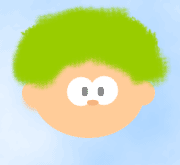[Currently working on it (apr 2005).]
So far:
COLLISIONS
----------
Part of what could be said about detecting collisions
when writing games can be understood by reading the
following interchange:
.......................................................
??? wrote:
I want to know a good way to implement 2d sprite
collision detection between main character sprite and
tile world. My game is 2D, main character 16x16, tiles
also has size 16x16 pixels. How to detect, for example,
that main character stands on the floor (to prevent
falling down) , or to detect character-walls detection?
Part of the reply:
It would much depend on the characteristics of your
floor. When I've done it in the past I haven't
bit-checked for collisions of sprites vs "tile"
(background). You can save a great deal of comparison
time if you simply do a mathematical range comparison,
according that is to the way your floor is laid out..
He continues:
Currently i do following to check collision against the
walls:
I pick 4 sprite corners i.e [x,y], [x+15, y], [x,
y+15], [x+15, y+15], next i get each tile code that
belongs to each corner:
tilecode = tilemap[y>>4][x>>4], and next i check that
each corner is not collide with any non-empty tile.
reply:
Again, you could save all that if you avoid bit collision
detection. As I understand it, I save bit
collision detections for what I call "active" situations.
By "active" I mean collisions that may affect my sprites
visually or dinamically, not their physics. An example
of "passiveness" would be bumping
into a wall. An example of "activeness" could be my
sprite walking over a floor of nails, or touching
something explosive, or plunging into a tub of acid, you
get the idea..
He continues:
To check collision with floor, I pick two points 1-
pixel under sprite and check that this points not in air,
otherwice I move my character down.
Is that correct? Please suggest me other (fastest?)
techniques to do sprite vs tilemap collision detection.
What if tilemap is moving freely (scrolled x-y)?
Reply:
If you consider what a collision is you'll realize that
it happens when particles coincide with each other in
"motionally conflicting" ways. What that means is that
on screen, the only way to get an honest-to-God collision
is to have two pixels occupying "the same space".
If you used that criteria to decide wether to move your
sprite up,down or in any direction, you realize that only
when a collision has taken place you will act in such a
way. But if you consider "real" collisions, it doesn't
really seem to happen that way: Before two points occupy
the same space, a lot of energy gets involved.
What that means is that when you bump into something,
although part of you interacts with whatever you bump
into atomically, most of your mass stays out of bounds
and you feel a force that keeps you from occupying the
space currently occupied by whatever you bump into. At
least that's what physicists say.
That would translate into computers as "feeling the
force" BEFORE actually colliding. I would suggest then
to look ahead AT LEAST one pixel in the direction of your
movement before displacing. That's the way I did it and
it works just fine.
If you consider, for example, a sprite character walking
over some "tile" floor from left to right, and at this
very moment the sprite character is "standing on the
floor" (his weight rests on the floor), then to move him
or her one pixel to the right you would consider the
vectors of movement involved, and then you could take
action. From there on it can get as complicated as you
need it.
One simple way to do it would be to set the sprite
animation as in motion, check before moving him to the
right when the time is right. If he's about to "bump"
into something (an obstacle) prevent him from advancing.
How can you tell the difference between the floor and any
obstacle, even when it's part of the same floor (i.e., a
wall or a lump in the terrain)? It's simple. His motion
vector gives you his direction. If there's anything in
that direction about to occupy the same space he would
like to occupy by moving that pixel to the right, even if
it's a single pixel, then you know he shouldn't move
that way. When you stop him from moving, PLEASE make him
respond elastically to the "bump". That means, don't
just stop his motion counter. Give him a little elastic
bounce, as it would happen in
everyday physics. It's a little trouble to program, but
the difference when your game is played is cosmic.
If your tilemap is moving freely then how you do it will
vary depending on the particular situation of your game
and on the angle of your view (your viewpoint), but the
principles should remain basically the same. It's
physics after all isn't it?
.......................................................
